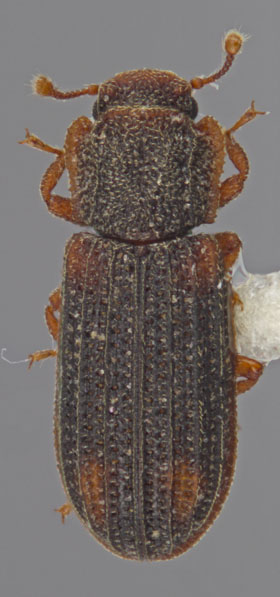 |
 Previous Genus Next Genus Previous Genus Next Genus 
Genus: Paha
Diagnostic Features
- Description: Antennae 10-segmented with a distinct, 1-segmented club. Antennal setation sparse. Subantennal grooves absent. Eyes large, well-developed, finely faceted. Pronotal disc convex with central depression, with two parallel, longitudinal carinae. Pronotal lateral margins widest anteriorly, distinctly explanate. Procoxal cavities open. Metacoxae narrowly separated, separation less than metacoxal length. Tarsal formula 4-4-4. Dorsum lacking obvious pubescence (if visible, then not distinct).
- Similar genera: The genus Paha is similar in general appearance to the other genera with 10-segmented antennae and a 1-segmented club that lack a subantennal groove, including Microsicus, Synchita, and Endeitoma. Microsicus differs in lacking pronotal carinae, and the dorsal surface with strongly curved, flattened, multi-colored elytral setae. The genus Synchita differs in lacking pronotal carinae, lateral pronotal margins widest at middle and not as distinctly explanate, and the dorsal surface with short, bristle-like setae. Endeitoma differs in having a long third antennal segment (at least twice as long as segment 4), pronotal disc lacking carinae, lateral pronotal margins distinctly denticulate, and a dorsal pubescence consisting of thin, fine, hair-like setae. In Paha, the pronotal disc has two parallel, longitudinal carinae, the lateral margins are widest anteriorly, distinctly explanate, antennal segment 3 is not distinctly elongate, and the dorsal pubescence is minute or lacking.
Known Distribution
- Northeast (DC, MD, NY, PA, VA), North Central (IN), Southeast (TN, AL, FL, MS, NC), South Central (OK) USA.
Biology
- Paha laticollis has been collected from under the bark of dead oaks.
- Abundance: Uncommon.
North American Species (1)
Selected References
|
 |
 
Paha laticollis
© N.P. Lord |
© 2011-2015 Lord, N.P., Nearns, E.H., and K.B. Miller
The University of New Mexico and Center for Plant Health Science and Technology, USDA, APHIS, PPQ.
|


